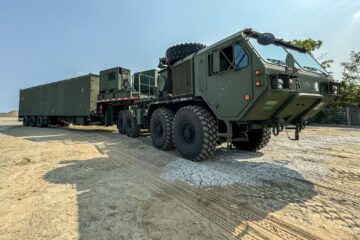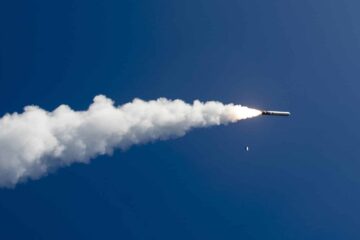Kelly Flynn, Public Affairs Specialist, U.S. Marine Corps Systems Command replied to Naval News’ inquiry at the end of May 2022 as to what kind of launcher the Marines will use for Tomahawk missiles on their trailers.
“The Marine Corps is using a derivative of the MK41 launcher. For security reasons, that information [the number of missiles per trailer] cannot be disclosed at this time.”
Kelly Flynn, Public Affairs Specialist, Marine Corps Systems Command
Asked on if the Mark 41 Vertical Launch System (VLS) cells on the trailers will fire anything else besides the Tomahawk Block V cruise missiles, Flynn replied, “The Marine Corps’ Long Range Fires program is only integrating the Tomahawk weapon system at this time.”Naval News has covered the Marine Corps’ quest in pursuing Land-based Tomahawk cruise missiles here.

At that time on June 21, 2021, the Marines requested 48+ Tomahawk missiles as part of their “Unfunded Priority List.” The Marines were actually budgeted 54 Tomahawk Block Vs in May 2022, six more missiles than they desired.
Naval News Comments

The USMC did not have any photos to share of their trailer launcher although photos do exist online showing a potential working Mark 41 VLS trailer cell prototype. Thus, the number of Tactical Land-Attack Missile (TLAM) Block V Tomahawks will most likely be four missiles per trailer.
The U.S. Army’s Rapid Capabilities and Critical Technologies Office (RCCTO) has a graphic slide showing the intended setup of the TLAMs on a trailer (see top photo) and this seems to coincide with a Naval News image showing a very similar setup (see photo below). The trailer changes to have three axles instead of two, most likely a 34-ton M872 trailer.
Although the RCCTO graphic is an U.S. Army setup, the graphic shows a firing battery of four trailers with four Mark 41 VLS launch cells on each trailer for a total of 16 Tomahawk TLAM missiles per battery. There is the Battery Operations Center (BOC) trailer with electronics, Command staff, communications and firing controls, a BOC Support Vehicle (most likely a HMMWV towing a power generator), a reload flatbed trailer with eight Tomahawk missile containers, and the associated Prime Mover tractors.
For the USMC, the Prime Mover will most likely be the Logistics Vehicle System Replacement (LVSR) tractor whereas the U.S. Army will use the M983A4 Heavy Expanded Mobility Tactical Truck (HEMTT) as the Prime Mover.

For speculative discussion purposes, if the Mark 41 VLS cells can be transported on land, does that mean that the entire Mark 41 VLS missile inventory can also be fired from land? Such a missile inventory includes the Standard family of missiles, the Evolved Sea Sparrow Missile (ESSM) the Anti-Submarine Rocket (ASROC), and in the future, the Long-Range Anti-Ship Missile (LRASM) that might get a VLS booster. If so, the ESSM and Standard can provide the USMC a Surface-to-Air and Surface-to-Surface striking capability at much higher speeds besides just using subsonic Tomahawk, providing Surface Strike and Anti-Air capabilities packed into one trailer (four ESSMs can fit into one Mark 41 VLS cell in a Mark 25 Quad-Pack).
The U.S. Army seems to be fielding the SM-6 Standard missile family, which may include some form of Ballistic Missile Defense (BMD) if networked with the proper “Sensor-to-shooter Kill Chain Web.”
The Mark 41 trailers with the missile canisters and launchers are transportable via C-130 “Hercules” cargo plane whereas the entire setup of the Mark 41 tractor-trailer can be transported by the future Light Amphibious Warship (LAW) if so desired.
The concept of firing Tomahawk cruise missiles from land-based trailers has taken several years to come into funding, acquisition, and fruition. Nonetheless, deals and treaties with allied hosting nations for setting up and firing these U.S. Army and USMC Mark 41 trailer missiles still need to be sorted out and signed into the agreement.







